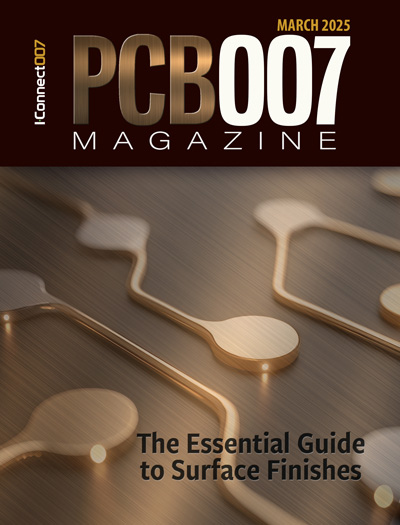-

- News
- Books
Featured Books
- pcb007 Magazine
Latest Issues
Current Issue
In Pursuit of Perfection: Defect Reduction
For bare PCB board fabrication, defect reduction is a critical aspect of a company's bottom line profitability. In this issue, we examine how imaging, etching, and plating processes can provide information and insight into reducing defects and increasing yields.

Voices of the Industry
We take the pulse of the PCB industry by sharing insights from leading fabricators and suppliers in this month's issue. We've gathered their thoughts on the new U.S. administration, spending, the war in Ukraine, and their most pressing needs. It’s an eye-opening and enlightening look behind the curtain.

The Essential Guide to Surface Finishes
We go back to basics this month with a recount of a little history, and look forward to addressing the many challenges that high density, high frequency, adhesion, SI, and corrosion concerns for harsh environments bring to the fore. We compare and contrast surface finishes by type and application, take a hard look at the many iterations of gold plating, and address palladium as a surface finish.
- Articles
- Columns
Search Console
- Links
- Media kit
||| MENU - pcb007 Magazine
Incheon National University Study Pioneers Breakthrough in Wireless Charging Technology
February 21, 2025 | PRNewswireEstimated reading time: 2 minutes
The efficiency of wireless charging systems is limited by power loss occurring due to frequency changes in the resonant circuits that enable power transfer. These necessary modulations reduce electromagnetic interference caused by resonant frequencies on other devices. However, conventional strategies for adapting to changing frequencies are inefficient, cost-prohibitive, and impractical. Now, scientists have designed a resonant tuning rectifier that provides a low-cost, efficient solution to stabilize power delivery in wireless power systems.
Wireless power transfer (WPT) enables device charging without direct physical or wired connections. Resonant circuits are key components of WPT systems that optimize energy transfer from the transmitter to the receiver. In parallel compensated receivers, capacitors balance the inductance of the receiver coil to achieve resonance, reducing circuit impedance, thereby enhancing power transfer.
The electromagnetic fields generated by such receivers can interfere with other electronic devices. Controlling this interference requires modulating the system's operating frequency. However, this modulation creates a mismatch between the modulated and resonant frequencies, severely degrading power output and system efficiency. Current strategies to correct this mismatch rely on additional hardware or complex circuitry, leading to energy loss, complex control settings, and bulkier designs.
In an attempt to find an innovative solution to overcome these challenges, a group of scientists led by Professor Dukju Ahn at Incheon National University, Korea, proposed a resonant tuning rectifier (RTR) for parallel resonant receiver systems. The novel RTR features a minimalist design that synchronizes its operation with the natural rhythm of the system's primary current. "Our RTR does not require extra power components or complex feedback circuitry, rendering it more practical for real-world use," says Prof. Ahn. The study was made available online on May 14, 2024 and was published in Volume 71, Issue 12 of IEEE Transactions on Industrial Electronics on December 01, 2024.
The RTR automatically adjusts effective capacitance to tune the resonant frequency by syncing control signals with the system's current, compensating for differences between intrinsic resonance and modulation periods. Unlike existing methods, it uses a simple sensor coil to extract phase information without impacting performance, eliminating the need for transmitter-receiver communication.
Testing a 2.2 kW prototype for automobile charging showed that the RTR compensates for frequency modulation (80—90 kHz) in 70 ms, maintaining stable power output during misalignment and improving efficiency from 3.5% to 8.1%. Its zero-voltage system optimizes control settings to reduce power loss, offering a simple, cost-effective solution for real-time adaptation and stable power delivery.
"The automatic adjustment of resonant frequency impacts not only wireless charging but also induction heating, plasma generation, and power conversion," explains Prof. Ahn. "With minimal energy loss, high efficiency, stable throughput, a minimalist design, and low system impact, RTR can significantly enhance wireless power system performance," he concludes. As wireless charging becomes more widespread, the proposed RTR offers a promising solution to mitigate existing challenges, making this technology more accessible to everyday users.
Suggested Items
AI Helps Build Smarter, More Resilient Power Grids
05/16/2025 | BUSINESS WIREAs society’s reliance on electricity deepens, artificial intelligence (AI) is reshaping how we manage power grids and optimize energy sources.
Corning Collaborates with Broadcom to Accelerate AI Data Center Processing Capacity
05/14/2025 | BUSINESS WIRECorning Incorporated, a world leader in glass science and optical physics, today announced a collaboration with Broadcom Incorporated, a leading supplier in the semiconductor field, on a co-packaged optics (CPO) infrastructure that will significantly increase processing capacity within data centers.
TT Electronics Secures £50 Million in New Contract Awards for Classified U.S. DoD Defense Programs
05/12/2025 | TT ElectronicsTT Electronics, a leading provider of global manufacturing solutions and engineered technologies, announced today that it has been awarded significant new contracts totalling over £50 million to support classified U.S. Department of Defense (DoD) programs.
LITEON Technology Reports Consolidated April Sales of NT$13.4 Billion Up 27% YoY
05/09/2025 | LITEON TechnologyLITEON Technology reported its April consolidated revenue of NT$13.4 billion. Thanks to the growth from power management in cloud computing, advanced server, and networking, the revenue is up 27% YoY.
NXP Unveils Third-Generation Imaging Radar Processors for Level 2+ to 4 Autonomous Driving
05/09/2025 | NXP SemiconductorNXP Semiconductors N.V. unveiled its new S32R47 imaging radar processors in 16 nm FinFET technology, building on NXP’s proven expertise in the imaging radar space.


